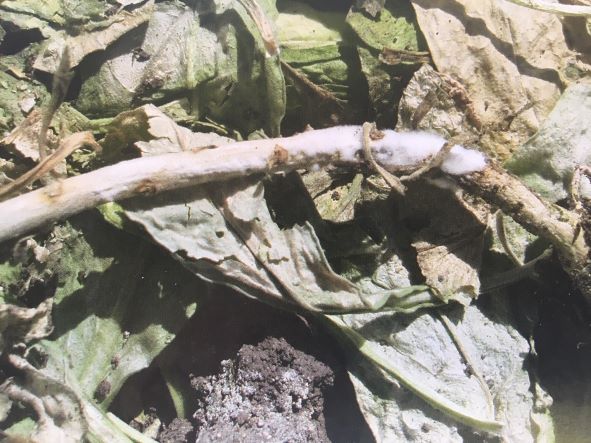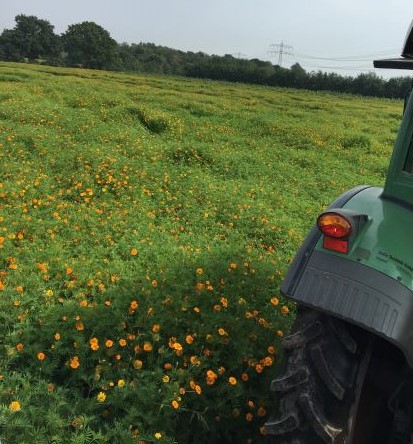Please click here to access the main AHDB website and other sectors.
- Home
- Knowledge library
- Alternative soil disinfestation options
Alternative soil disinfestation options
Several non-steaming, soil disinfestation options are available or in development, although their current applicability to intensive cut flower production is limited.
Soil disinfestation options for cut flower growers
Steam-free disinfestation options
Heat treatment
Direct heat treatment
Tractor-trailed equipment that removes the top surface of soil, heats it in a rotating drum with a flame, and then lays it as a treated bed is available.
Crop debris burners
Propane burners pulled behind a tractor can be used for disinfestation of the soil surface. Temperatures that reach over 900°C kill weeds, pathogens and pests in the top 1–2 cm of soil and rely on minimal soil disturbance before the next crop.
Crop debris burners are mainly used against weeds following harvest and Sclerotinia species, but also provide some control of pupating insect pests, such as leaf miners and thrips, and weed seeds near the soil surface. It is a treatment that should be used in combination with other soil disinfestation methods and is particularly useful for destroying surface crop debris that may harbour pathogens or pests. Crop burners are permitted for use in organic production systems. There are various models of burners available in various sizes and capacities, suitable for both glasshouse and outdoor use.
Remove crop debris before soil treatment, Fusarium in woody tissues is difficult to kill

Courtesy and copyright of ADAS Horticulture.
Biofumigation
Certain brassica species (green manure crops) are planted by growers as a means of suppressing soilborne pathogens, pests and weeds. These plants are incorporated and produce toxic isothiocyanates when they break down in the soil (similar to methyl isothiocyanate produced by the chemical fumigant active ingredients dazomet and metam-sodium). Further work is ongoing to optimise treatments, including timing, species choice and method of incorporation into the soil to improve the consistency of effects.
BioFence, Brassica carinata granules, have been used instead of growing a crop. This process requires vapour-proof sheeting to be applied over the soil surface after incorporation and addition of water (the granules are moisture activated).
In addition to brassicas, other crops are being used as biofumigants, including Sudan grass (Sorghum vulgare) to suppress Verticillium dahliae and nematodes, and Tagetes species (for example Tagetes 'Nema Mix') to reduce nematode populations.
Tagetes ‘Nema Mix’ grown for nematode suppression

Copyright of AHDB.
Organic soil amendments
The use of various organic soil amendments, including composted green waste, animal manures and by-products of agriculture, forestry and food industries, has been shown to suppress some soilborne plant pathogens. However, the level of suppression achieved is notoriously variable. The potential presence of human pathogens in some materials and factors affecting the consistency of suppression requires further study. The use of organic soil amendments can be useful as part of an integrated strategy for the reduction of soilborne pathogens and pests.
Biological control
Contans WG (Coniothyrium minitans) is available as a pre-planting treatment to control soilborne Sclerotinia species. The fungus colonises and degrades the resting bodies in crop debris or the soil. There is potential for greater use of biological control using other micro-organisms, such as Trichoderma species, including T34 Biocontrol (Trichoderma asperellum strain T34) as a component of integrated management of soilborne pathogens and pests.
Limited duration of effect, variable efficacy under different growing conditions and a narrow range of activity are the main drawbacks. An increasing number of products are also being sold that contain one or more micro-organisms and claim to improve plant growth and/or general resistance to disease.
The addition of potentially beneficial micro-organisms to soil immediately after disinfestation may reduce the risk of re-colonisation by plant pathogens that grow rapidly through sterile soil, such as Fusarium species and Rhizoctonia solani.
Radio frequency and microwave heating
The use of both radio frequency (RF) and microwave (MW) treatments to apply electromagnetic energy to soil to control soilborne pathogens, pests and weeds have been investigated. These methods are not currently economical and require costly equipment and large energy inputs.
A prototype machine (‘Agritron’) that heats soil by electromagnetic waves has been developed in the Netherlands as an alternative to steaming. A multiple-wheeled tractor is used to pull a magnetron unit over the soil at speeds of up to 1 metre per minute.
Treatment of sandy soils is easiest, with disinfestation up to 50 cm depth. The treatment is reported to be effective against Fusarium and Pythium species, nematodes and weeds. The potential advantage of this system over steaming is the saving in physical labour and fuel costs; the makers claim it is 80% cheaper than steaming. The magnetron is powered by electricity and requires a diesel generator. The equipment is not currently available for commercial use.
Hot air treatment
Hot air soil sterilisers have been developed. These include a rotary spading machine that treats soils with 800°C dry air, using as little as one-tenth the energy required for steaming. The combination of blowing hot air into moving humid soil as it is cultivated enables each soil particle to reach a high temperature. In tests, treatment reduced nematode numbers, but the effect on soil fungi was not studied. The machine, which is large and heavy, treats 2.7–6.0 metres per minute outside but less inside a glasshouse. Hot air disinfestation has been used commercially in Israel for several years, and improvements in subsequent crop growth noted. However, research in the Netherlands using a machine with a hot air temperature of 720°C found no immediate reduction in nematode numbers (Meloidogyne fallax) following treatment.
Other methods
A wide range of other chemical, physical and biological methods have been and continue to be investigated. They are not considered here because the methods detailed here are currently considered more practical and effective options.
Useful links
Further information on green manure crops can be found in the HDC/AHDB factsheet 24/10 ‘Green manures – effects on soil nutrient management and soil physical and biological properties’.
Authors
Author(s) – Dave Kaye and Erika Wedgwood. ADAS Horticulture.
Original author(s) – Tim O’Neill and Kim Parker. ADAS Horticulture.
Webpage content correct as of June 2021.
Topics:
Sectors:
Tags:

